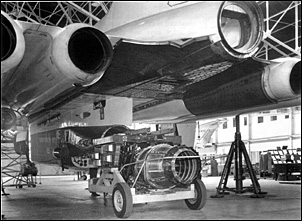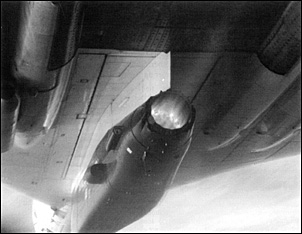Home Introduction
History
Blue Steel
Olympus 593

Vulcan B1 XA903 & RB199

![]() In August 1971 the aircraft went to Marshall's of Cambridge
for nacelle conversion to the RB199 configuration and it returned to
Filton in February 1972. Unlike the Olympus programme, the RB199 programme
was bedevilled with test engine failures and shortage, the flying rate
being seriously curtailed as a result. In the seven years that the
programme continued, only 126 flights were achieved giving a total of 286
hours flying time and 203 engine test hours in flight.
In August 1971 the aircraft went to Marshall's of Cambridge
for nacelle conversion to the RB199 configuration and it returned to
Filton in February 1972. Unlike the Olympus programme, the RB199 programme
was bedevilled with test engine failures and shortage, the flying rate
being seriously curtailed as a result. In the seven years that the
programme continued, only 126 flights were achieved giving a total of 286
hours flying time and 203 engine test hours in flight.
The RB199 nacelle represented a starboard installation, the simulated Tornado fuselage being split on the centreline. The intake and nozzle geometry was fully representative and functional, the only compromise being with the reverse buckets, which were mounted laterally, were non-functioning, but which were fully representative aerodynamically. The original submission had made provision for a twin-engined installation, but fortunately in view of the engine supply situation, the design was revised to provide for only a single test engine. The forebody, that part of the nacelle that projected ahead of the test engine, had been designed to provide two 27mm Mauser cannon positions together with ammunition stowage for 150 shell.
The age of the Vulcan began to be a problem during the RB199 flying, and spares were not always readily available, as the last of the RAF's B1s had been withdrawn from service in 1968. Frequently a component unserviceability would lead to the country being scoured for the required item, at times even 'gate guardians' being robbed to provide needed parts.

![]() In mid-1977
a spate of electrical problems revealed that the aircraft wiring had
deteriorated to the point that the insulation had become water absorbent.
The aircraft was rewired in 3 months, the only time that this task was
carried out on a Vulcan. The feat becomes all the more impressive when one
realises that the wiring was 'built-in', and was not designed to be
replaced.
In mid-1977
a spate of electrical problems revealed that the aircraft wiring had
deteriorated to the point that the insulation had become water absorbent.
The aircraft was rewired in 3 months, the only time that this task was
carried out on a Vulcan. The feat becomes all the more impressive when one
realises that the wiring was 'built-in', and was not designed to be
replaced.
During the RB199 development, a 27mm Mauser cannon was fitted to the forebody, and several gun firing trials were carried out on the butts at Boscombe Down, and under the control of Aberporth Radar over the Irish Sea. XA903 thus became the only cannon-armed Vulcan had a sealed pressurised cabin, the crew was positive that during the gun firing trials they could smell cordite.
As a young man Brian Lloyd remembers the first flight with the RB199 fitted:
'When it made it's first flight with the RB199 fitted, I got a picture of it on short finals coming in over the A38 on my recently acquired Zenith SLR camera. As the flight had been long awaited and progress and problems closely monitored by Flight International, I sent the film off to them, only to have it appear in the next week's edition. In the letter they sent me with my cheque for £20, they said they couldn't credit the shot to me as the installation was officially classified!
'Not that I cared, a picture published in Flight, from the very first roll of film I put through my very first camera was reward enough. I've never had another photo published since!'
